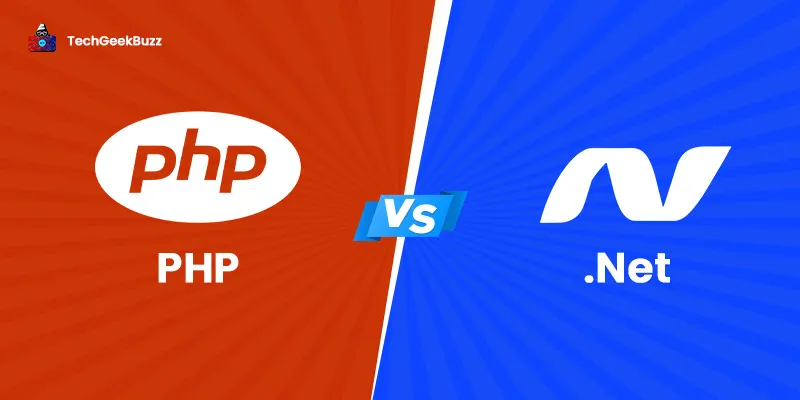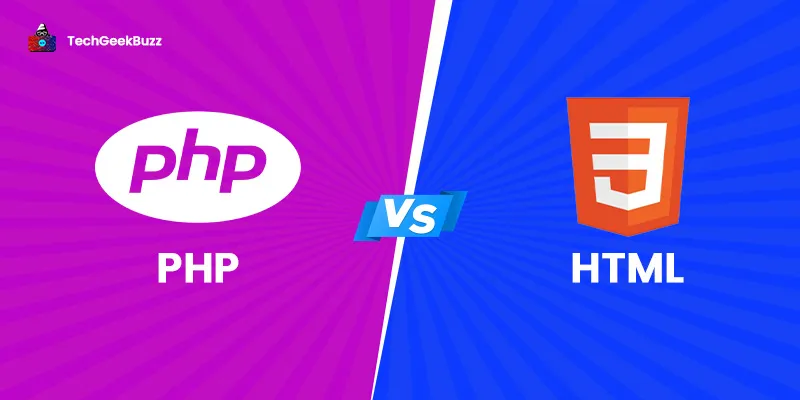The web development industry has reached its tipping point as more businesses choose to have an online presence. As a result, to make the development of responsive websites and web applications hassle-free, a plethora of technologies are available out there.
PHP and .NET are among the most popular technologies for web development. While PHP is a server-side scripting language, .NET is a software development platform that supports multiple programming languages, including C#, F#, and Visual Basic.
If you're having trouble deciding between PHP and.NET for web development, you've come to the right place.
This article aims to make you familiar with the key differences between PHP and .NET to make it easier for you to choose between the two. Also, it makes you familiar with the features, benefits, and drawbacks of PHP and .NET.
So, let us begin our discussion!
What is PHP?
Hypertext Preprocessor is the full form of PHP. It is an open-source, server-side scripting language that many developers leverage for web development. The primary use of PHP is to create websites and web applications that are static and dynamic in nature. In addition, another popular application of PHP is observed in the development of content management systems (CMS).
Besides, it lets you retrieve data from forms, create sessions, work seamlessly with databases, create eCommerce websites, and send and receive cookies.
You can embed PHP within HTML code to create dynamic web content. It is an interpreted language, and the PHP interpreter executes PHP code on the web server. After executing PHP code, the corresponding result can be any type of data, whether HTML or binary image data.
Since it is a server-side language, you need to install PHP only on the server. There is no need to install PHP on other client computers; only a web browser would work.
History
Rasmus Lerdorf, in 1994, wrote multiple Common Gateway Interface (CGI) programs in C for maintaining his personal home pages. Later, he extended those programs to be compatible with web forms and connect with databases. He called this new implementation "Personal Home Page/Forms Interpreter" or PHP/FI.
However, PHP/FI was only able to create simple dynamic web apps. Later, Lerdorf released PHP/FI as "Personal Home Page Tools (PHP Tools) version 1.0 that significantly improved code and accelerated bug reporting. This version had features that today’s PHP possesses, including form handling and Perl-like syntax.
In 1997, Zeev Suraski and Andi Gutmans rewrote PHP’s parser, which served as a base for PHP 3. In addition, they also changed the name to a recursive acronym: PHP (Hypertext Preprocessor). Further, they rewrote PHP’s core, created the Zend Engine version 1.0 in 1999, and formed the base for PHP 4.
After developing Zend Engine II, they used it to design PHP 5 and released it in 2005. Multiple versions of PHP were released later with new functionalities and enhancements to the existing features. The current and stable version of PHP is PHP 8.1, released in November 2021.
Features
The salient features of PHP are as follows:
- Loosely-Typed: Since PHP does not require you to define the data type of variables while declaring them, it is a loosely-typed language. However, the PHP interpreter takes care of the data type of variables based on their values at runtime.
- Interpreted Language: As an interpreted language, the PHP interpreter reads the source code line by line and executes it accordingly.
- Cross-Platform Compatibility: PHP can run on any operating system and environment. Some common environments that PHP supports are XAMPP and LAMP.
- Error Reporting and Exception Handling: PHP comes with error reporting constants that generate errors or warnings at runtime. These constants include E_ERROR, E_WARNING, E_PARSE, and E_STRICT. Moreover, PHP 5 provides support for exception handling.
- Database and Web Server Support: One of the major uses of PHP is to connect to databases; it supports a wide range of databases, including MySQL, MariaDB, MongoDB, PostgreSQL, Oracle, and SQLite. In addition, Apache, Microsoft IIS, and Netscape are the popular web servers that PHP supports.
- Memory Usage Information: PHP provides functions, like memory_get_usage() or memory_get_peak_usage() that help you retrieve memory usage information.
- Object-Oriented: PHP supports data abstraction and inheritance concepts of the object-oriented programming principle.
Advantages
The following are the noteworthy benefits of PHP:
- It is a flexible language since it enables us to integrate PHP code with other languages, including HTML, JavaScript, and XML.
- PHP is open-source, and you can use any of its components without paying a dime.
- It has a huge community of active developers who contribute their knowledge and help beginners get out of the major issues they face during development.
- You will find comprehensive documentation for PHP on its official website. Through this, you will obtain the fundamental knowledge you need to start with PHP.
- PHP is a faster scripting language than other languages, including JSP, ASP.NET, and Perl.
- It is a secure language since many pre-defined functions support data encryption. Also, PHP supports other third-party applications to keep our data secure.
- Learning PHP is pretty easy if you have hands-on experience with the C language.
- The mighty library of PHP comes with various modules you can use for data representation.
Disadvantages
Some major drawbacks of PHP are as follows:
- It is not an ideal language if you wish to create a huge content-based website.
- As PHP is a loosely-typed language, it can result in incorrect knowledge and data for users.
- With PHP, you cannot change the core behavior of online applications.
- If you multiple features of PHP simultaneously while creating online applications, it results in poor performance.
- It is not a component-modular language, and hence, it becomes challenging to manage PHP code.
What is .NET?
.NET, also known as Dot NET, is an open-source, unified development platform that lets you create a variety of applications. It supports multiple programming languages, libraries, and text editors to facilitate the creation of the web, desktop, and mobile applications. Also, be mindful of the fact that it also allows you to create games and IoT applications.
With the .NET framework, you can create applications in C#, Visual Basic, and F#. When you create code using any of these languages, it runs natively on any supported operating system. However, this robust framework is compatible with only Microsoft Windows.
Moreover, .NET supports Common Language Infrastructure (CLI), which compiles your source code into Common Intermediate Language (CIL), irrespective of the programming language you use. Not only does this CLI compiles C#, F#, and Visual basic languages but also many other languages, including IronPython, PowerBuilder, and the list goes on.
History
Microsoft began the development of the .NET Framework in the early 1990s. In 2000, the company released the first beta version of .NET, i.e., .NET 1.0. During this time, Microsoft and Intel worked together to make Common Language Interface (CLI) and C# standardized. In 2001, both CLI and C# were officially the ECMA standards and the ISO standards in 2003.
In 2007, the company announced the release of source code for .NET Framework 3.5 libraries under the Microsoft Reference Source License (Ms-RSL) and made it available online in 2008. These libraries included Windows Forms, XML, BCL, ASP.NET, WPF, and ADO.NET.
Features
The following are the noteworthy features of .NET:
- Common Executive Environment: The Common Language Runtime (CLR) is the common executive environment in .NET that executes code written in any supported programming language. This environment makes it possible for the code written in one language to interact with the code written in another language.
- Multi-Language Support: .NET Framework supports multiple languages. This framework manages the compilers of each language for converting the source code into intermediate code. Later, the intermediate code is converted into native code. Version 2.0 of the framework supports around 45 languages.
- Automatic Resource Management: The Common Language Runtime (CLR) offers automatic resource management. It manages memory, databases, screen space, network connections, and many other resources. In addition, whenever you create new objects, CLR allocates memory to them by invoking various .NET built-in functions.
- Common Type System (CTS): The .NET framework follows the common type system (CTS) to ensure data integrity is maintained across the code written in various .NET supported languages. It also prevents data loss while transferring a type in one language to the same type in another language. For instance, CTS prevents data loss when you transfer a variable of an integer type of C# code to the variable of integer type of F# code.
- Framework Class Library (FCL): As its name suggests, this library consists of a number of classes you can use in your code. These classes are intended to accomplish various tasks, such as drawing graphics, web services, carrying out input-output operations, data access, and dealing with data storage.
- Debugging Support: .NET leverages Visual Studio IDE, which comes with debugging support. In case of errors, the IDE halts the program and highlights the line containing the error with details and possible solutions. This makes it easy for programmers to rectify problems in their code.
Advantages
Some remarkable upsides of the .NET Framework are as follows:
- It comes with a reliable and powerful caching system. Also, it has made the cache implementation customizable. As a result, developers can boost the performance of their programs dramatically.
- Since .NET houses the Visual Studio IDE, you can write programs without any hassle and debug them quickly, right from the IDE.
- It is an open-source framework accessible to anyone wishing to develop cross-platform applications.
- This framework makes the deployment and maintenance of applications effortless since it comes with a wide range of developer tools.
- It has a modular design. As a result, the applications you develop are ultimately modular in nature.
- Since .NET supports multiple programming languages, many developers with expertise in various languages use it. This made it possible for .NET to build a huge community.
- Backed by Microsoft, .NET evolves with the time and comes with new updates and releases.
Disadvantages
Here are the significant downsides of the .NET Framework:
- Though it is an open-source framework, some of its aspects may charge you the licensing costs. For instance, it uses Visual Studio, which may require licensing fees.
- When there are new releases of the framework, it lacks proper documentation and support.
- Though .NET has a garbage collector, developers have to put extra effort into managing memory allocation.
- Since this framework falls under the Microsoft products, any limitations or changes the company imposes directly impact the projects done under this framework.
PHP vs .NET - A Detailed Comparison
The following table describes the key differences between PHP and .NET:
|
Parameters |
PHP |
.NET (Dot NET) |
|
Definition |
It is a server-side scripting language that lets you create websites and web applications. |
It is a software development framework that allows developers to create web, desktop, mobile, and IoT applications. |
|
Developed By |
Rasmus Lerdorf designed the PHP language. |
The Microsoft Corporation developed the .NET Framework. |
|
Based on |
C and C++ programming languages form the basis of PHP. |
C, C++, assembly language, and a few framework classes in C# form the basis for the .NET framework. |
|
Use |
The primary use of PHP is for creating static and dynamic websites and web applications. |
The primary use of .NET is for creating web and desktop applications. |
|
Open-source |
PHP is open-source. |
The .NET Framework is open-source as well as licensed. |
|
Language Support |
It does support a lot of languages. However, a PHP file can contain HTML, CSS, and Javascript code. |
This framework supports a wide range of programming languages, including Visual Basic, C#, and F#. |
|
Used By |
Facebook, Slack, Wikipedia, and WordPress are some renowned companies and websites that use PHP. |
Microsoft, Accenture, and Stack Overflow are some popular companies that use .NET. |
PHP vs .NET - Which is Better?
From the comparison table, we can conclude that both PHP and .NET are ideal for web development. However, be mindful of the fact that PHP is a scripting language, whereas .NET is a development framework. Moreover, .NET enables developers to build desktop, mobile, and IoT applications.
Both PHP and .NET are scalable solutions for web development and are used by many renowned tech giants. As a result, the decision between the two depends on personal preferences.
Conclusion
Here, we've come to the end of our discussion about the differences between PHP and.NET. Both of these technologies are widely used in web development. Before choosing any programming language or framework for web development, make sure to check its performance, compatibility with various platforms, scalability, cost, and support and maintenance.
We hope you found this post informative and useful. If you are aware of more differences between PHP and .NET other than the ones mentioned above, post in the comments section below.




